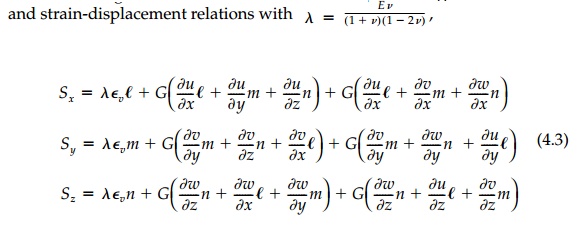Chapter: Civil : Principles of Solid Mechanics : Strategies for Elastic Analysis and Design
Tactics for Analysis
Tactics for
Analysis
There are two clear
plans of attack: a) determine the vector field for displace-ments and then
differentiate to find the strains and stresses, or b) determine the tensor
field and integrate to find the displacements. In either case, we can try all
sorts of educated guesses or other tricks to shorten the process which, with
either approach, is sometimes then called the semi-inverse method.
Direct Determination
of Displacements
Direct determination of displacements is
clearly the more obvious strategy and intuitively satisfying since this is what
we actually see and can measure. Using the definitions of strains in terms of
the relative displacements, and substituting the strain relationships Equation
(3.2) becomes:

These are the Navier
Field Equations* and they are very nice indeed. Fifteen equations have been
reduced to only three second-order differential equations in terms of the
components of the displacement vector field, which must be smooth and
continuous. Moreover, if there is no volume change (naturally, or if = 0.5) and
no body force, the displacement field is harmonic. Even if is lin-ear and the body forces constant, the
equations are manageable. Unfortunately, the complications introduced through
the boundary conditions expressed in terms of displacements more than counterbalance
the simplicity of the field equations and usually make the direct closed-form
determination of the displacement field intractable.
Transforming the traction BCs [Equation
(2.11)] and using the stress-strain

Seldom are the
displacements or their derivatives known on the boundary and Equations (4.3)
end up as integral equations which can only be evaluated numerically (the basis
of the boundary integral method).
Direct Determination
of Stresses
Direct determination of stresses is an
alternative tactic for analysis. Finding a tensor field involving six unknowns
rather than three would appear to be a step backwards, but it is not. Shortly
after introducing the concept of stress in its general tensor representation,
Cauchy* recognized its field properties and the advantages of expressing
boundary conditions in terms of equilibrium. Combining the stress-strain
relations with the compatibility Equation (3.6) and the equilibrium Equation
(3.43), and letting:

In this case, ![]() v
is harmonic if the body force is constant or zero. Even some of the individual
stress components can be harmonic in certain circumstances.
v
is harmonic if the body force is constant or zero. Even some of the individual
stress components can be harmonic in certain circumstances.
In summary, then,* we
have developed two fundamental and unified descriptions of the intertwined
scalar (![]() v and
v and ![]() v),
vector (
v),
vector ( ![]() Bar = ui + vj + wk), and tensor
(
Bar = ui + vj + wk), and tensor
( ![]() ij
?
ij
? ![]() ij ) fields of elasticity. We can try to either:
ij ) fields of elasticity. We can try to either:
![]()
1. Determine
the vector displacement field and differentiate to obtain the tensor field, or
2. Determine
the tensor stress field, convert to strains and integrate, if possible, to
obtain the vector field.
The first tactic is preferable in every
way except in practice. We therefore will concentrate on the second approach
for closed-form solutions although reference will often be made to the first,
particularly in the chapter on torsion.
Related Topics